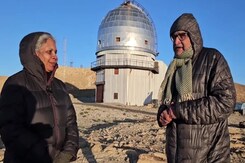Astronomy
- All
- News
- Videos
- Web Stories
-

Astronomers Spot Galaxies Moving in Sync Across a 50-Million-Light-Year Stretch
- Friday December 5, 2025
- Written by Gadgets 360 Staff
Astronomers have identified a 50-million-light-year-long cosmic filament in which 14 gas-rich galaxies all rotate in sync with the structure itself. The filament, mapped about 140 million light-years away, appears young, cold and shaped by slow cosmic flows. Galaxies on opposite ends move in opposite directions, suggesting the entire filament is sp...
-
 www.gadgets360.com
www.gadgets360.com
-

Supermoon and Geminid Meteor Shower 2025 Set to Peak Soon: How to See It
- Thursday December 4, 2025
- Written by Gadgets 360 Staff
The 2025 Geminid meteor shower peaks on December 13–14, offering bright, frequent meteors under dark skies thanks to a thin crescent Moon. Originating from asteroid 3200 Phaethon, the Geminids can produce over 100 meteors per hour. Best viewing is after midnight from clear, dark locations.
-
 www.gadgets360.com
www.gadgets360.com
-

James Webb Space Telescope Spots an Exoplanet Losing Its Atmosphere in a Huge Helium Stream
- Thursday December 4, 2025
- Written by Gadgets 360 Staff
Astronomers using NASA’s James Webb Space Telescope have observed a massive helium cloud escaping from the super-puff exoplanet WASP-107b, marking the first direct detection of such atmospheric loss. Webb’s infrared data reveal an enormous exosphere nearly ten times the planet’s radius, with helium streaming both ahead of and behind the plane...
-
 www.gadgets360.com
www.gadgets360.com
-

China's Zhuque-3 Reaches Orbit but Booster Explodes in Failed Landing Attempt
- Thursday December 4, 2025
- Written by Gadgets 360 Staff
China’s private launch company, LandSpace, successfully sent its Zhuque-3 rocket to low Earth orbit on its maiden flight, delivering its payload with an expendable upper stage. But the mission took a dramatic turn during recovery when one of the booster’s engines stalled in the landing burn, causing the stage to erupt in flames just meters from...
-
 www.gadgets360.com
www.gadgets360.com
-

Scientists Find Clock on Mars Runs 477 Microseconds Faster Than Earth
- Thursday December 4, 2025
- Written by Gadgets 360 Staff
A new study by NIST physicists shows that clocks on Mars run about 477 microseconds faster per day than identical clocks on Earth. The difference comes from Mars’s weaker gravity, orbital eccentricity, and gravitational influences across the solar system. Though tiny, this daily time lead will pose challenges for future Mars navigation and commun...
-
 www.gadgets360.com
www.gadgets360.com
-

Indian Team Finds 53 Massive Quasars Blasting Jets Millions of Light-Years Long
- Tuesday December 2, 2025
- Written by Gadgets 360 Staff
Astronomers in India have identified 53 previously unknown giant radio quasars powered by supermassive black holes, each releasing enormous plasma jets reaching up to 7.2 million light-years—nearly 50 times the Milky Way’s diameter. Using GMRT data, the team expanded the catalog of known giant quasars and offered valuable clues about how black ...
-
 www.gadgets360.com
www.gadgets360.com
-

New Gravitational-Wave Signal May Reveal Primordial Black Holes Born After the Big Bang
- Monday December 1, 2025
- Written by Gadgets 360 Staff
Scientists have spotted an unusual gravitational-wave signal that may reveal the universe’s first primordial black holes—tiny relics dating back to the Big Bang. Recorded by LIGO–Virgo–KAGRA in November 2025, the event involves an object far lighter than any known stellar remnant. If verified, it could reshape theories of black holes and da...
-
 www.gadgets360.com
www.gadgets360.com
-

James Webb Space Telescope Finds Unexpected Ultraviolet Radiation Around Young Protostars
- Monday December 1, 2025
- Written by Gadgets 360 Staff
Astronomers using the James Webb Space Telescope have detected unexpected ultraviolet radiation around five young protostars in the Ophiuchus molecular cloud. Since infant stars are not expected to emit UV light, the finding challenges long-standing star-formation models. Researchers ruled out external illumination from nearby stars, concluding the...
-
 www.gadgets360.com
www.gadgets360.com
-

New Study Models How Interstellar Objects Could Approach and Impact Earth
- Sunday November 30, 2025
- Written by Gadgets 360 Staff
A new study simulating billions of hypothetical interstellar objects finds that potential Earth-crossing bodies would most likely arrive from the solar apex and the galactic plane. The research highlights relative approach patterns rather than predicting real impacts. Scientists emphasise that known visitors like ‘Oumuamua and Borisov pose no dan...
-
 www.gadgets360.com
www.gadgets360.com
-

NASA Confirms Third Interstellar Visitor 3I/ATLAS Is a Natural Comet
- Sunday November 30, 2025
- Written by Gadgets 360 Staff
NASA has confirmed that interstellar object 3I/ATLAS is a natural comet, not alien technology. The comet shows unusual carbon-dioxide and nickel vapours, offering a rare look at ancient material from another star. Its path is safe, staying about 1.8 AU from Earth during its Solar System passage.
-
 www.gadgets360.com
www.gadgets360.com
-

Fermi Telescope Detects Gamma-Ray Halo That Could Be First Direct Dark Matter Signal
- Saturday November 29, 2025
- Written by Gadgets 360 Staff
NASA’s Fermi Gamma-ray Space Telescope has detected a faint halo of high-energy gamma rays around the Milky Way’s centre—matching predictions for dark-matter annihilation. The finding, reported by Professor Tomonori Totani, could represent the first direct glimpse of dark matter, but scientists caution that alternative explanations remain and...
-
 www.gadgets360.com
www.gadgets360.com
-

X-Ray Nebula Discovery Brings Astronomers Closer to Solving Cosmic Ray Mystery
- Friday November 28, 2025
- Written by Gadgets 360 Staff
A new study has linked an unexplained LHAASO detection to a pulsar-powered X-ray nebula, confirming it as a rare PeVatron capable of accelerating particles to extreme energies. The discovery is a major step toward solving the long-standing mystery of galactic cosmic rays. Researchers are now combining X-ray, gamma-ray and neutrino observations to t...
-
 www.gadgets360.com
www.gadgets360.com
-

China’s Massive JUNO Experiment Delivers Its First World-Class Neutrino Results
- Friday November 28, 2025
- Written by Gadgets 360 Staff
China’s Jiangmen Underground Neutrino Observatory has delivered world-class results after only 59 days of data collection, achieving the most precise measurements yet of two major neutrino oscillation parameters. JUNO’s early performance surpasses all previous experiments, confirming a small but intriguing discrepancy between solar and reactor ...
-
 www.gadgets360.com
www.gadgets360.com
-

Comet C/2025 K1 (ATLAS) Breaks Into Three Pieces Following Close Approach to the Sun
- Tuesday November 25, 2025
- Written by Gadgets 360 Staff
NASA's fractured comet C/2025 K1 (ATLAS) dazzled stargazers on Monday night, offering a rare live view of a cosmic object breaking apart after a close encounter with the Sun. The livestream, organised by the Virtual Telescope Project, began at 10 p.m. EST on November 24 (0300 GMT on November 25) and will broadcast telescopic views of the comet's mu...
-
 www.gadgets360.com
www.gadgets360.com
-

James Webb Telescope May Have Discovered Universe’s Earliest Supermassive Black Hole
- Tuesday November 25, 2025
- Written by Gadgets 360 Staff
James Webb may have discovered the universe’s earliest supermassive black hole in galaxy GHZ2. Observations reveal high-energy emission lines, challenging existing models of rapid black hole and galaxy growth. Upcoming JWST and ALMA studies aim to confirm AGN activity and refine our understanding of early cosmic evolution.
-
 www.gadgets360.com
www.gadgets360.com
-

Astronomers Spot Galaxies Moving in Sync Across a 50-Million-Light-Year Stretch
- Friday December 5, 2025
- Written by Gadgets 360 Staff
Astronomers have identified a 50-million-light-year-long cosmic filament in which 14 gas-rich galaxies all rotate in sync with the structure itself. The filament, mapped about 140 million light-years away, appears young, cold and shaped by slow cosmic flows. Galaxies on opposite ends move in opposite directions, suggesting the entire filament is sp...
-
 www.gadgets360.com
www.gadgets360.com
-

Supermoon and Geminid Meteor Shower 2025 Set to Peak Soon: How to See It
- Thursday December 4, 2025
- Written by Gadgets 360 Staff
The 2025 Geminid meteor shower peaks on December 13–14, offering bright, frequent meteors under dark skies thanks to a thin crescent Moon. Originating from asteroid 3200 Phaethon, the Geminids can produce over 100 meteors per hour. Best viewing is after midnight from clear, dark locations.
-
 www.gadgets360.com
www.gadgets360.com
-

James Webb Space Telescope Spots an Exoplanet Losing Its Atmosphere in a Huge Helium Stream
- Thursday December 4, 2025
- Written by Gadgets 360 Staff
Astronomers using NASA’s James Webb Space Telescope have observed a massive helium cloud escaping from the super-puff exoplanet WASP-107b, marking the first direct detection of such atmospheric loss. Webb’s infrared data reveal an enormous exosphere nearly ten times the planet’s radius, with helium streaming both ahead of and behind the plane...
-
 www.gadgets360.com
www.gadgets360.com
-

China's Zhuque-3 Reaches Orbit but Booster Explodes in Failed Landing Attempt
- Thursday December 4, 2025
- Written by Gadgets 360 Staff
China’s private launch company, LandSpace, successfully sent its Zhuque-3 rocket to low Earth orbit on its maiden flight, delivering its payload with an expendable upper stage. But the mission took a dramatic turn during recovery when one of the booster’s engines stalled in the landing burn, causing the stage to erupt in flames just meters from...
-
 www.gadgets360.com
www.gadgets360.com
-

Scientists Find Clock on Mars Runs 477 Microseconds Faster Than Earth
- Thursday December 4, 2025
- Written by Gadgets 360 Staff
A new study by NIST physicists shows that clocks on Mars run about 477 microseconds faster per day than identical clocks on Earth. The difference comes from Mars’s weaker gravity, orbital eccentricity, and gravitational influences across the solar system. Though tiny, this daily time lead will pose challenges for future Mars navigation and commun...
-
 www.gadgets360.com
www.gadgets360.com
-

Indian Team Finds 53 Massive Quasars Blasting Jets Millions of Light-Years Long
- Tuesday December 2, 2025
- Written by Gadgets 360 Staff
Astronomers in India have identified 53 previously unknown giant radio quasars powered by supermassive black holes, each releasing enormous plasma jets reaching up to 7.2 million light-years—nearly 50 times the Milky Way’s diameter. Using GMRT data, the team expanded the catalog of known giant quasars and offered valuable clues about how black ...
-
 www.gadgets360.com
www.gadgets360.com
-

New Gravitational-Wave Signal May Reveal Primordial Black Holes Born After the Big Bang
- Monday December 1, 2025
- Written by Gadgets 360 Staff
Scientists have spotted an unusual gravitational-wave signal that may reveal the universe’s first primordial black holes—tiny relics dating back to the Big Bang. Recorded by LIGO–Virgo–KAGRA in November 2025, the event involves an object far lighter than any known stellar remnant. If verified, it could reshape theories of black holes and da...
-
 www.gadgets360.com
www.gadgets360.com
-

James Webb Space Telescope Finds Unexpected Ultraviolet Radiation Around Young Protostars
- Monday December 1, 2025
- Written by Gadgets 360 Staff
Astronomers using the James Webb Space Telescope have detected unexpected ultraviolet radiation around five young protostars in the Ophiuchus molecular cloud. Since infant stars are not expected to emit UV light, the finding challenges long-standing star-formation models. Researchers ruled out external illumination from nearby stars, concluding the...
-
 www.gadgets360.com
www.gadgets360.com
-

New Study Models How Interstellar Objects Could Approach and Impact Earth
- Sunday November 30, 2025
- Written by Gadgets 360 Staff
A new study simulating billions of hypothetical interstellar objects finds that potential Earth-crossing bodies would most likely arrive from the solar apex and the galactic plane. The research highlights relative approach patterns rather than predicting real impacts. Scientists emphasise that known visitors like ‘Oumuamua and Borisov pose no dan...
-
 www.gadgets360.com
www.gadgets360.com
-

NASA Confirms Third Interstellar Visitor 3I/ATLAS Is a Natural Comet
- Sunday November 30, 2025
- Written by Gadgets 360 Staff
NASA has confirmed that interstellar object 3I/ATLAS is a natural comet, not alien technology. The comet shows unusual carbon-dioxide and nickel vapours, offering a rare look at ancient material from another star. Its path is safe, staying about 1.8 AU from Earth during its Solar System passage.
-
 www.gadgets360.com
www.gadgets360.com
-

Fermi Telescope Detects Gamma-Ray Halo That Could Be First Direct Dark Matter Signal
- Saturday November 29, 2025
- Written by Gadgets 360 Staff
NASA’s Fermi Gamma-ray Space Telescope has detected a faint halo of high-energy gamma rays around the Milky Way’s centre—matching predictions for dark-matter annihilation. The finding, reported by Professor Tomonori Totani, could represent the first direct glimpse of dark matter, but scientists caution that alternative explanations remain and...
-
 www.gadgets360.com
www.gadgets360.com
-

X-Ray Nebula Discovery Brings Astronomers Closer to Solving Cosmic Ray Mystery
- Friday November 28, 2025
- Written by Gadgets 360 Staff
A new study has linked an unexplained LHAASO detection to a pulsar-powered X-ray nebula, confirming it as a rare PeVatron capable of accelerating particles to extreme energies. The discovery is a major step toward solving the long-standing mystery of galactic cosmic rays. Researchers are now combining X-ray, gamma-ray and neutrino observations to t...
-
 www.gadgets360.com
www.gadgets360.com
-

China’s Massive JUNO Experiment Delivers Its First World-Class Neutrino Results
- Friday November 28, 2025
- Written by Gadgets 360 Staff
China’s Jiangmen Underground Neutrino Observatory has delivered world-class results after only 59 days of data collection, achieving the most precise measurements yet of two major neutrino oscillation parameters. JUNO’s early performance surpasses all previous experiments, confirming a small but intriguing discrepancy between solar and reactor ...
-
 www.gadgets360.com
www.gadgets360.com
-

Comet C/2025 K1 (ATLAS) Breaks Into Three Pieces Following Close Approach to the Sun
- Tuesday November 25, 2025
- Written by Gadgets 360 Staff
NASA's fractured comet C/2025 K1 (ATLAS) dazzled stargazers on Monday night, offering a rare live view of a cosmic object breaking apart after a close encounter with the Sun. The livestream, organised by the Virtual Telescope Project, began at 10 p.m. EST on November 24 (0300 GMT on November 25) and will broadcast telescopic views of the comet's mu...
-
 www.gadgets360.com
www.gadgets360.com
-

James Webb Telescope May Have Discovered Universe’s Earliest Supermassive Black Hole
- Tuesday November 25, 2025
- Written by Gadgets 360 Staff
James Webb may have discovered the universe’s earliest supermassive black hole in galaxy GHZ2. Observations reveal high-energy emission lines, challenging existing models of rapid black hole and galaxy growth. Upcoming JWST and ALMA studies aim to confirm AGN activity and refine our understanding of early cosmic evolution.
-
 www.gadgets360.com
www.gadgets360.com



































